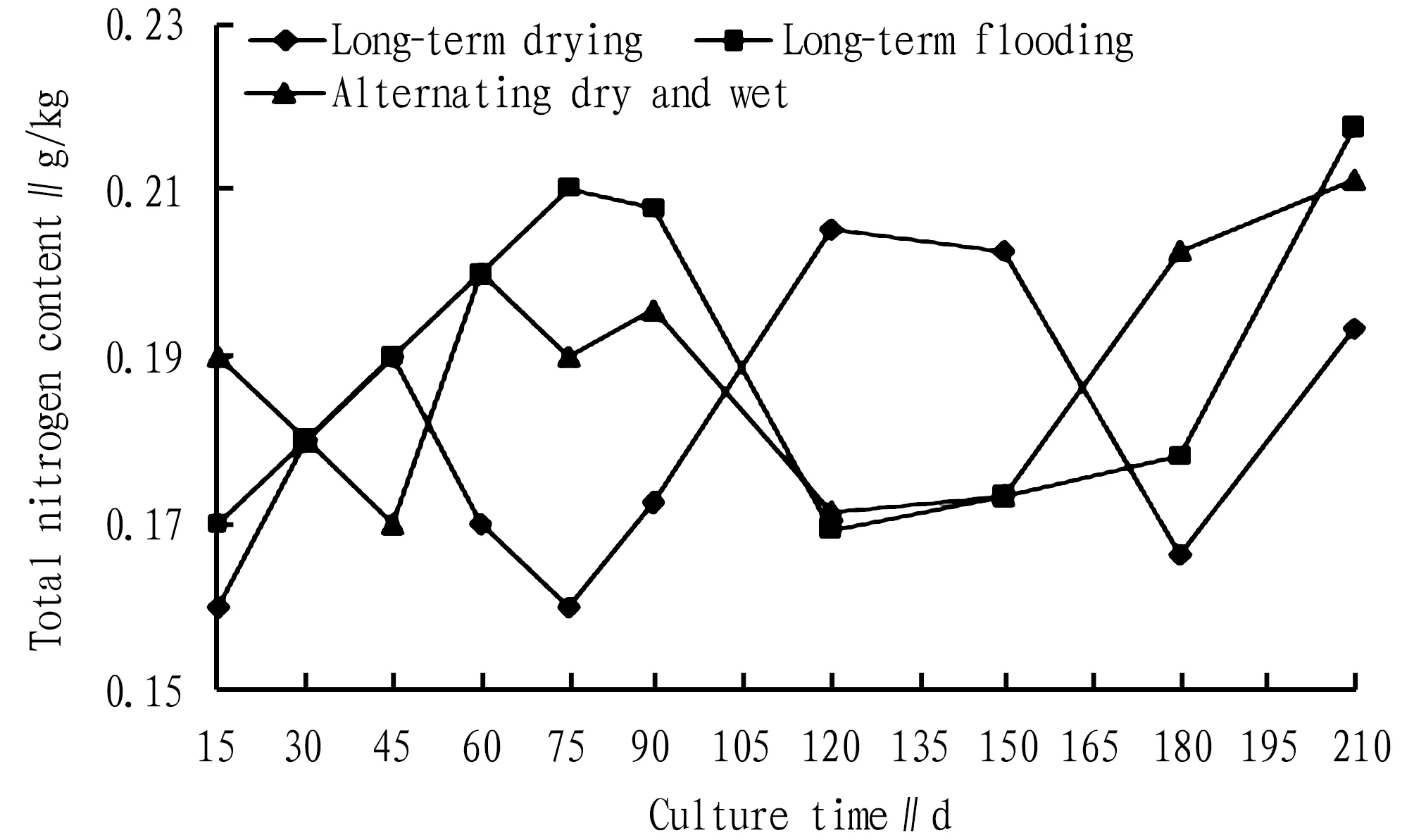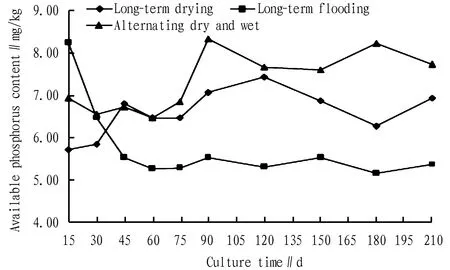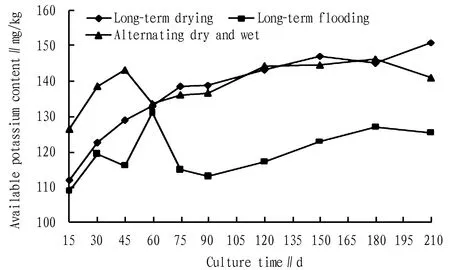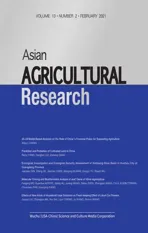Activation Effect of Hydrochemical Energy in Regenerative Agriculture on Nutrients of Arsenic Sandstone
2021-04-08TingtingMENGDanWU
Tingting MENG, Dan WU
Shaanxi Provincial Land Engineering Construction Group Co., Ltd.; Institute of Land Engineering and Technology, Shaanxi Provincial Land Engineering Construction Group Co., Ltd.; Key Laboratory of Degraded and Unused Land Consolidation Engineering, Ministry of Natural Resources; Shaanxi Provincial Land Consolidation Engineering Technology Research Center, Xi’an 710075, China
Abstract [Objectives] To study the activation effect of hydrochemical energy in regenerative agriculture on the nutrients of arsenic sandstone. [Methods] Starting from common environmental factors, moisture, it studied the mechanism of the release and activation of N, P, K nutrient elements in arsenic sandstone under different dry and wet environments. [Results] Water played a positive role in activating soil elements. Under the conditions of long-term dryness and alternating dry and wet conditions, the content of total nitrogen, available phosphorus and available potassium coexisted in the 210 d of culture and the element absorption and release, but the overall trend was increasing; under long-term flooding conditions, the content of total nitrogen and available potassium showed an overall increasing trend during the 210 d of culture, but the content of available phosphorus decreased. [Conclusions] Water plays a positive effect on activating soil elements. The research results are expected to provide a certain reference for the application research of water in regenerative agriculture.
Key words Water, Arsenic sandstone, Regenerative agriculture, Total nitrogen, Available phosphorus, Available potassium, Nutrient activation
1 Introduction
Regenerative agriculture refers to the use of self-healing and repair capabilities of the nature to rebuild soil health, improve plant resistance, and continuously regenerate agricultural natural resources. At present, measures of regenerative agriculture mainly include cover crops, multiple crop rotations, rotation grazing, no-tillage or the use of compost, manure, natural fertilizers and improvers (without synthetic substances prohibited in organic methods),etc
. This form of production has a high degree of inherent economic and biological stability, and has the least impact on the environment outside the farm or cultivated land. The activation of soil nutrient elements has become a research hotspot in the field of land engineering. It has obvious advantages over ordinary fertilizers in terms of improving nutrient utilization, reducing environmental pollution and labor input. In this situation, how to use the existing medium in nature to activate soil nutrient elements so as to achieve the purpose of regenerative agriculture is an urgent problem to be solved. In this experiment, starting from the common environmental factor moisture, we studied and analyzed the mechanism of the release and activation of N, P, K nutrient elements in arsenic sandstone under different dry and wet environmental conditions. In order to avoid the use of pesticides and other agrochemicals, we strive to provide food for the growing population in the conversion process that is least dependent on non-renewable resources.2 Materials and methods
2.1 Experimental design
We selected arsenic sandstone as the test soil, which was air-dried through a 2 mm sieve, and 10 samples were placed individually in beakers, with 200 g samples in each beaker. In this experiment, we designed 3 treatments, including long-term drying, long-term flooding, and alternating dry and wet, with 3 replicates for each treatment. Under long-term drying conditions, all soil samples were cultured in an oven, and the temperature was set to 40 ℃. Under long-term flooding treatment conditions, all soil samples were cultured at room temperature in the laboratory, and the water surface was maintained 2 cm higher than the soil sample, the beaker was covered with plastic wrap to reduce evaporation, the soil samples were kept in a saturated anaerobic environment, and the temperature was recorded every day. Under alternate dry and wet treatment conditions, the water flooding and dry culture time of all soil samples were each 1/2 of the total culture time, the drying culture was undertaken in an oven and flooding was carried out in a laboratory.2.2 Determination of indicators
For the first 6 times, soil samples were taken every 15 d, and for the last 4 times, soil samples were collected every 30 d. The collected soil samples were passed through a 1 mm sieve and a 0.149 mm sieve. The soil screened with the 1 mm sieve was used to determine the content of soil available phosphorus and available potassium, and the soil sample screened with the 0.149 mm sieve was used to determine the total nitrogen content of the soil. The determination method was based on the determination method of soil available phosphorus in the third edition ofSoil
Agro
-chemistrical
Analysis
edited by Bao Shidan, namely, 0.5 mol/L NaHCOextraction colorimetric method. The determination method of soil available potassium was NHAc extraction and flame spectrophotometry. The determination method of soil total nitrogen was semi-micro Kjeldahl method.2.3 Data processing
The data were processed and charts were plotted with the aid of Excel 2020.3 Results and analysis
3.1 Changes in total nitrogen content
From Fig.1, it can be seen that the total nitrogen content of arsenic sandstone after long-term drying treatment showed an increasing trend in the first 45 d, and a decreasing trend in the first 45-75 d, and an increase first and then a decrease in the 75-150 d. The lowest value appeared on the 15d and was 0.16 g/kg; the highest value appeared on the 120d and was 0.21 g/kg, an increase of 23.8% from the 15d. Long-term drying exerted an important impact on soil nitrogen mineralization. In this experiment, the content of arsenic sandstone increased with the increase of drying time, possibly because long-term drying increased the content of ammonia nitrogen, nitrate nitrogen and free amino acids, thereby increasing the total nitrogen content in the soil. Under long-term water flooding conditions, the total nitrogen increased from 0.17 to 0.21 g/kg during 15-75 d, and the release appeared; but during 75-180 d, it decreased from 0.21 to 0.18 g/kg and it started to increase again on the 210d. These indicate that the total nitrogen shows a stepwise increase and decrease under water flooding conditions. Flooding will lead to increased soil nitrogen loss, mainly due to the loss of nitrogen denitrification and denitrification. Under the alternating dry and wet conditions, the total nitrogen content decreased in the first 45 d, increased in the first 45-90 d, decreased in the 90-150 d, and increased in the 150-210 d. The lowest value (0.17 g/kg) appeared on the 45, 120, and 150d, and the highest value (0.21 g/kg) appeared on the 210d.
Fig.1 Total nitrogen content of arsenic sandstone under different treatments
3.2 Changes in available phosphorus content
From Fig.2, it can be seen that under long-term drying, the available phosphorus content of arsenic sandstone was the lowest at 5.7 mg/kg on the 15d of the initial culture; on the 120d, it reached the maximum value of 7.4 mg/kg, an increase of 29.8%; during this period, there was release of phosphorus; then the available phosphorus content began to decrease, reaching 6.9 mg/kg on the 210d. Under long-term drying, the absorption and release of available phosphorus coexist, but the overall trend is increasing. Under long-term flooding conditions, the available phosphorus in arsenic sandstone showed a decreasing trend, it was 8.2 mg/kg on the 15d of the initial culture period; it was 5.4 mg/kg on the 210d of the final culture period, a decrease of 34.1%. Under alternating dry and wet conditions, the lowest value of available phosphorus in arsenic sandstone appeared on the 60d of culture and was 6.5 mg/kg; the highest value appeared on the 90d of culture and was 8.3 mg/kg; there was phosphorus during the alternation of dry and wet. The absorption of phosphorus also released phosphorus. Under alternating dry and wet conditions, phosphorus in the soil was released and its chemical form became active, thereby increasing the content of available phosphorus in the soil.
Fig.2 Available phosphorus content of arsenic sandstone under different treatments
3.3 Changes in the content of available potassium
From Fig.3, it can be seen that the available potassium content of arsenic sandstone tends to increase under long-term drying. It was 112 mg/kg on the 15d of the initial culture period and 151 mg/kg on the 210d of the final culture period, an increase of 34.8%. Under long-term flooding, the content of available potassium in the arsenic sandstone showed an overall increasing trend. The lowest value appeared on the 15d of the initial cultivation period, which was 109 mg/kg; the maximum value appeared on the 60d of the cultivation site, which was 131 mg/kg, an increase of 20.2%; however, it was 125 mg/kg on the 210d of the end of culture, which was an increase of 14.7% compared with the 15d of the initial period of culture. Under the alternating dry and wet conditions, the content of available potassium in the arsenic sandstone showed a trend of first increasing and then decreasing. It was 126 mg/kg on the 15d of the initial culture; but on the 45d of the culture, it was 143 mg/kg, an increase of 13.5%, and then it began to decrease, possibly because potassium is reduced, and ferrous iron and manganese are relatively large, which replaces the potassium ions adsorbed by the soil, causing potassium ions to activate, accordingly leading to an increase in soil available potassium content. Taking Beijing cinnamon soil as the research object, Li Mengxunet
al
.found that the soil available potassium content is higher under constant hu- midity, and it may increase with the increase in the frequency of alternating dry and wet.
Fig.3 Available potassium content of arsenic sandstone under different treatments
4 Conclusions
Through this experiment, we found that water has a positive effect on activating soil elements. Under the conditions of long-term drying conditions and alternating dry and wet conditions, the content of total nitrogen, available phosphorus and available potassium in the arsenic sandstone coexisted in element absorption and release during 210 d of culture, but the overall trend was increasing. Under long-term flooding conditions, the content of total nitrogen and available potassium in the arsenic sandstone showed an overall increasing trend during the 210 d of culture, but the content of available phosphorus decreased.
杂志排行
Asian Agricultural Research的其它文章
- Ecological Investigation and Ecological Security Assessment of Xizhijiang River Basin in Huizhou City of Guangdong Province
- Molecular Cloning and Bioinformatics Analysis of araC Gene of Vibrio alginolyticus
- Occurrence Regularity and Integrated Control Technology of Canker in Citrus
- IS-LM Model Based Analysis on the Role of China’s Financial Policy for Supporting Agriculture
- Prediction and Protection of Cultivated Land in China
- Emergy Estimation of the Main Forest Biomass in Shangri-La, Tibetan Area of Yunnan Province
